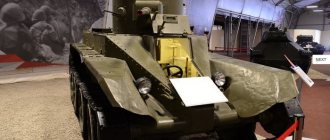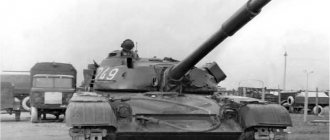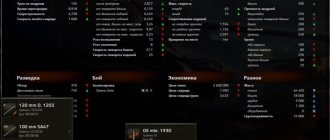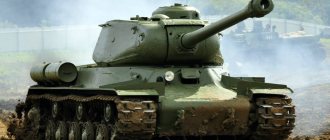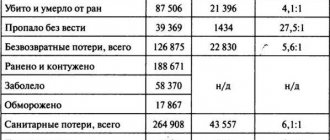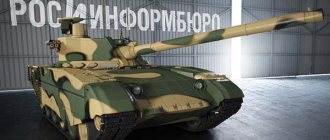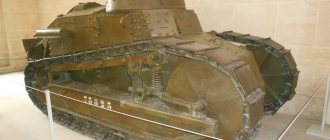Characteristics of the BT-5 high-speed tank
A country:USSRType:Fast tankDate of issue:1933Length:5.58 mWidth:2.23 mHeight:2.23 mArmor, forehead:13 mmArmor, side:13 mmArmor, tower:13 mmCrew:3 personsEngine:Carburetor M-5, 400 hp.Travel range:150 km (on tracks), 200 km (on wheels).Maximum speed:52 km/h (on tracks), 72 km/h (on wheels).Weight:11.5 tonsWeapons:1x 45 mm gun 20-K mod. 1937, 1x 7.62 mm DT machine gun
“Soviet high-speed tank BT-5 - history of creation, characteristics and modifications”
Performance characteristics
It is generally accepted that the BT-7, the most advanced representative of the series, was unrivaled in the 30s, but by the beginning of the Great Patriotic War it was irrevocably outdated.
But let’s compare its parameters with the British Crusader tank, which is similar in concept, and the German Pz.III, the most modern modification by 1941.
| BT-7 | Mk.VI Crusader | Pz.IIIAusf.J | |
| Weight, t | 14,2 | 19,3 | 21,5 |
| Length, m | 5,6 | 5,9 | 5,5 |
| Armor thickness, mm | 15-20 | 18-34 | 30-50 |
| Maximum speed, km/h | 52/72 | 43 | 40 |
| Cruising range, km | 375/460 | 255 | 155 |
| Armament | 45 mm cannon, 1-3x7.62mm machine gun | 40 mm cannon, 2x7.7 mm machine gun | 50mm cannon, 2x7.92mm machine guns |
Of course, the BT-7 also had fatal shortcomings, such as a cramped body caused by the use of Christie suspension. There were also those that, in principle, could be overcome, such as the lack of high-quality observational instruments. However, a 45mm cannon in 1941 was a completely adequate weapon, and in terms of mobility the BT-7 was superior to its competitors even without the use of wheels. The Crusader, protected little better than a Soviet tank, was used quite successfully in the African campaign.
Obviously, the platform had already exhausted its potential for modernization, but the BT-7 was not “limitedly combat-ready.” On the contrary, he could well give German technology a worthy rebuff.
However, the wear and tear of the components took its toll (remember that the production of spare parts was curtailed along with the serial production of the tank), adding to the confusion in the first weeks of the blitzkrieg. Finally, they switched to ambush tactics, which made it possible to attack the enemy even with better visibility and thicker armor, only in the fall of 1941. Before this, they even tried to repel enemy attacks with a counter frontal attack - this method was prescribed in the regulations.
The BT series tanks were an impressive achievement in tank building.
Even if we remember their American origin, it was the Soviet designers who managed to bring Christie’s ideas “to mind” and create a formidable combat vehicle based on his prototypes. It was the BT tank (and not the “ceremonial” T-35), which participated in many wars and reached the finals of World War II, that was supposed to be a symbol of the power of the armored forces of the Red Army.
The tank problem of the early 1930s
Tanks in the USSR in the early 1930s. not enough. By and large, everything that could be mastered was put into mass production. The real combat qualities of these vehicles were, by and large, secondary - in order to secure the country, first of all, it was necessary to show the neighbors that tanks were being built in the USSR, so that they would think twice before dictating their orders.
Yesterday only Chamberlain had tanks, today we have them too!
Drawing of the BT-5 light tank
Advantages and disadvantages
Having familiarized ourselves with the parameters of BT-5 , let’s briefly summarize its capabilities.
Advantages:
- high rate of fire;
- good DPM;
- excellent accuracy;
- comfortable UVN;
- excellent dynamics;
- good maneuverability.
Flaws:
- small alpha strike;
- low armor penetration;
- complete lack of armor;
- the low weight of the vehicle makes it vulnerable to ramming even from other light vehicles;
- small viewing radius.
History of the creation of the BT-5 tank
The BT-2 “fast tank” was not the worst vehicle, but an “intermediate” one - produced only until a worthy replacement was found. There were enough shortcomings and complaints in its design. It is for this reason that they tried to replace it with something more formidable as soon as possible.
Although there were quite progressive ideas for creating improved versions of the BT-2: the BT-4 and BT-6 tanks, preference was given to the BT-5 version. Unlike its “neighbors” by numbers, the BT-5 differed from the “two” only in a new turret and a set of weapons, plus modifications to the chassis, etc., which is called “little things”. But it also had a significant advantage: unlike the “four” and “six”, the “five” did not require reworking the production line, and could be put into production almost simultaneously, on the same units as the BT-2. How can one not joke about the fact that for “fast tanks” not only speed in battle was important, but also speed in production.
Fast tank BT-5
In March 1933, the BT-5 replaced the BT-2 on the assembly line. Initially, the vehicle was equipped with two types of turrets - “Izhora” (welded, with a large niche at the rear, originally designed for the T-26 tank) and “Mariupol” (riveted, with a small niche at the rear). However, starting from 1935, due to defects discovered in the products of the plant in Mariupol, the BT-5 was equipped only with “Izhora” turrets. Almost all of the “defective” tanks were sent to training units.
In a relatively short period of time, the BT-5 has gone through a rather active development path. Started as a variant of the strengthened BT-2, by 1934 it received a new M-17T engine with 500 hp, a completely changed main clutch and a reinforced gearbox. This is not to mention the band brakes and improved armor.
Production of the BT-5 tank was completed on the eve of 1935; a total of 1,884 tanks of this type were produced.
Tank BT-5 with a turret from the Mariupol plant
Tracks and wheels: The rebirth of the tank
This tank was pulled out in the Nevsky Piglet area only on the second attempt - and this happened on June 18 of this year.
We can say that the number “18” for the tanks of the diorama museum is significant. Thus, the very first tank from the museum’s collection was raised on April 18, 2003, and the installation date of the exhibits often fell on this date - of course, in different months and different years.
Now on the site of the diorama museum there are three tanks, previously raised from the bottom of the Neva: KV-1, T-26 and T-38, as well as a KV-1S, pulled out of a forest swamp.
"Empty" tank
It takes a lot of time to restore such a war trophy. If you are lucky and the car is in good condition (only cosmetic repairs are required), then four people can do it in a couple of months. And a relatively complete restoration of the tank takes years. The hardest part is assembling broken combat vehicles and searching for missing parts.
The newcomer to the BT-5 was lucky - already upon lifting it, experts noted that the tank was in good condition: even the rubber tires on the wheels were perfectly preserved. However, outwardly the armor was not very damaged, but the inside of the tank was heavily oxidized - tin objects and signs crumbled in the hands of museum employees.
The equipment of the raised BT-5 turned out to be very “empty”: by the time it sank, the city had long been under siege. Spare parts (spare tool accessories) were barely half equipped.
But the miners discovered a complete stack of shells, and it was from them that they were able to determine the time of the tank’s flooding: the date “1942” was on all the bottoms. At the same time, the capsules were non-standard, very different - it is clear that they were assembled from what was at hand in the besieged city. In addition, the shells were fired 5-10 times - the cartridges were collected and loaded again.
Difficult repair
First of all, the pulled out tank was sandblasted and then dismantled - literally down to the nut. The parts were sanded down to bare metal, primed, painted and reassembled. The metal of the tank is all “shells”, so the craftsmen had to put on three layers of ship’s primer and three layers of paint (this took as much as 100 liters!).
Moreover, the work required clean, dry weather, and the primer had to be applied within several hours after sandblasting - until the metal oxidized.
Missing parts (for example, a steering wheel) were looked for in the most exotic places. Old metal for the missing parts was found in the ship's "graveyard": otherwise the new parts would look unnatural on the tank.
Collections of tanks are mainly created at former defense enterprises that were previously involved in their production. An exhibition of this kind at the diorama museum is the first in the country. And, of course, it is possible to maintain it in proper condition only thanks to the help of enthusiastic sponsors.
This is exactly the situation that arose with the KV-1S high-speed tank, which was restored and assembled with the help of the Real Estate Bulletin Group of Companies. The same company took an active part in the rise of a newcomer to the exhibition - BT-5.
Vera Pozdnyakova, director of the “Breakthrough the Siege of Leningrad” museum-reserve, says that the people who help the museum deserve a separate book. “And I will definitely write about them!” - she claims.
History of BT
“The armor is strong, and our tanks are fast!” – These lines of the famous song are dedicated specifically to the BT tank. On their basis, flamethrower and even radio-controlled models were created. From 1932 to 1940, more than 8,000 BT tanks of various modifications were produced. They fought at Lake Khasan, at Halkin Gol, in Poland, Finland, and were also widely used at the very beginning of the Great Patriotic War.
The main advantage of BT tanks was that, having lost their tracks, they successfully continued their journey on wheels.
BT5 was created at the Kharkov Locomotive Plant as a result of work to improve the combat characteristics of the Christie M.1940 tanks, purchased from the American George Walter Christie in April 1930 and put into mass production in the USSR under the BT2 brand.
Christie's required highly skilled workers; In addition, at this time, armor steel and wear-resistant materials were created for roller tires, clutch discs, etc. All this significantly increased the capabilities of the BT5 tank, which was first assembled in October 1932.
Subsequently, this tank was the base vehicle for the development of prototypes of the BT5IS tank, the KhBT5 chemical tank, a bridge layer, tanks with missile weapons and a tank torpedo. In addition, equipment for underwater driving and overcoming water obstacles by swimming, as well as swamp tracks, were tested on the BT5 tank.
The found BT5 is believed to have sank on September 28, 1942 during the 2nd Sinyavinsk offensive operation.
Next in line is a barge with vehicles.
Igor Devyatnikov, employee of the Museum Diorama “Breakthrough the Siege of Leningrad”, who is restoring the BT5 tank:
– The ascent from the Neva is very difficult: the depth is 17-20 m, the current is very strong. Underwater filming of a tank, for example, was only possible when we were hiding behind it. In an open current - which is about 2.5 m/sec at the bottom - it is impossible to remove the car.
Now it seems to us a very interesting object, a barge with transport, sunk on Ladoga, on the “Road of Life” - with “Stalinist” tractors, railway tank platforms and some other wheeled equipment.
We still can’t understand what it is, but it’s definitely not a machine – perhaps some kind of aggregates. Perhaps we will raise this barge next. True, this will not be easy: the barge is 75 m long, and it is flooded far from the shore. Unfortunately, the safety of the vehicles will be different - tanks, of course, are better preserved.
In addition, if you weld a hatch into the tank, it will stand at the exhibition like a safe - it will not be easily damaged. With a tractor, for example, everything is different. But you can install a railway tank if you weld the hatch, just like in a tank.
In general, a lot of interesting equipment awaits us at the bottom of the Neva and Lake Ladoga. And we would really like to pick it up and show it to people.
An extraordinary museum
Vera Pozdnyakova, director of the Museum-Reserve “Breakthrough the Siege of Leningrad”:
– Our exhibition of tanks is unique - they all date back to the 30s of the last century, they are the first, experimental. All of them exist, if not in single copies, then very rare. For example, there are only two BT-5 tanks on display. One of them, which has been repaired several times, is located in the light tanks pavilion at the Museum of Armored Weapons and Equipment in Kubinka, near Moscow. Another is erected as a monument on top of Mount Bain Tsagan in Mongolia. We will have a third one.
We are now developing the area in front of the Diorama Museum “Breaking the Siege of Leningrad.” And in the fall we will have not only BT-5, but also, for example, armored caps, which are now in the forest. The exhibition area will be surrounded by a fence, there will be security - now we can’t even put signs in front of the tanks!
And the second stage of work on the BT-5 will be its restoration from the inside - so that the tank can be started and it will drive. This kind of work is difficult and expensive, but we want to achieve it. The rest of our tanks are on the move.
We dream that we will have a special ring where we can organize parades of our equipment. But this, unfortunately, is a very distant prospect.
How to get there?
By car: along the Murmansk highway to the Ladoga Bridge over the Neva (Kirovsk, 55 km from St. Petersburg). Further - according to the index. The museum-diorama “Breakthrough the Siege of Leningrad” is located in the bridge support.
Without a car: bus and minibus No. 565 and 575 from the station. metro station "Ulitsa Dybenko" (to the stop "Museum-Diorama").
The museum receives visitors daily from 11 to 18 hours. Closed on Monday. The last Friday of every month is sanitary day.
Design of the BT-5 tank
The layout of the tank is classic. The design of the hull of the “high-speed tank” BT-5 generally repeats the design of the BT-2, the turret (“Izhora”) is similar to the turret of the T-26 light tank . On the sides of the turret there are two viewing slits and two openings for firing from a revolver. The roof of the tower had a hatch that could be locked from the inside for entry and exit of the crew. In the later part of the turret there was a hole for ventilation and a periscope sight. The main armament of the BT-5 tank is a 45-mm cannon coupled with a DT machine gun. The machine gun had its own open sight and could fire independently of the gun.
The shells were placed on the floor of the fighting compartment, placed in vertical clips on the right and left walls of the hull, and also occupied the walls and niche of the turret. Machine-gun discs occupied space above the shell stowage in the fighting compartment.
The tank's crew consists of 3 people; observation of the battlefield is carried out through sights and two viewing devices with bulletproof glass located on the side walls of the turret.
The command tanks had a 71-TK-1 radio station with a handrail antenna on the turret, which was later replaced with a whip antenna. The ammunition load of command tanks with a radio station was reduced.
Light tank BT-5 in profile
Armament
The standard armament of the BT-2 was the B-3 37mm cannon, created on the basis of the German PaK 35 anti-tank gun. The DT machine gun was not coaxial with the cannon, but was installed next to it in a ball mount. An optical sight was used to aim the gun at the target. Some tanks were released without a machine gun, and some, due to a lack of guns, were equipped with twin machine gun mounts.
Starting with the BT-5, the vehicles were armed with a 45 mm 20K cannon and a coaxial DT machine gun.
The telescopic sight was supplemented with a panoramic periscope. Some BT-7s also had DT machine guns in the rear of the turret and an anti-aircraft machine gun on the turret roof. The “artillery” BT-7A, produced in small quantities, was equipped with a 76mm KT cannon (the same one was installed on the T-28 and T-35 tanks).
Modifications of the BT-5 tank
- BT-5 - linear tank (1933-1934). Armament: 45-mm tank gun of the 1932 model and a DT machine gun, 1621 vehicles were produced;
- BT-5RT - tank with radio station 71-TK-1 or 71-TK-3 (1933-1934). Armament: 45-mm tank gun model 1932 and DT machine gun, 263 vehicles produced:
- KhBT-5 (BKhM, BKhM-2) - chemical (flame-thrower) tank (1936). Armament: 45 mm tank gun mod. 1932, DT machine gun and flamethrower installation or removable smoke device TDP, 10 flamethrower tanks and 3 tanks for setting smoke screens were produced;
- BT-IS - a tank with a modified hull shape and six driving wheels (1937). Armament: 45-mm tank gun model 1932-1934. and a DT machine gun, a small batch of vehicles was produced;
- BT-5/V-2 - modernized tank (1939). Linear tank BT-5, equipped with a V-2 diesel engine, 5 vehicles were produced;
- BT-SV-2 (BT-SV) - a tank with a modified hull and turret shape (1937). Armament: 45-mm tank gun model 1932-1934. and a DT machine gun, 2 prototypes were produced;
- BT-TT - telemechanical group of BT tanks (1939-1941). Composition: teletank armed with a KS-60 flamethrower and a 7.62-mm Silin machine gun; control tank armed with a 45-mm tank gun model 1934-1938. and a DT machine gun, an experimental group of vehicles was released.
- BT-5PH is an underwater tank.
- RBT-5 is an experimental missile tank.
BT-5 high-speed tank with a 76 mm gun
• Directory of armored vehicles •
Source: compilation based on publicly available information on the Internet
Combat use
The first BTs to enter combat were the BT-5s, which the Soviet Union supplied to the Spanish Republicans. In Spain, the BT-5 performed well, showing superiority over the light German tanks that the Francoists were armed with. However, neither the BT-5 nor their Soviet crews were able to turn the tide of the war in favor of the Republicans.
BT-7 first took part in the battles at Lake Khasan, and in 1939 both BT-5 and BT-7 covered themselves with glory in the battles at Khalkhin Gol. There, the speed and maneuverability of the BTS showed their best side, but shortcomings were revealed (or confirmed) - the fire hazard of the gasoline engine, the weakness of bulletproof armor, and difficulty in controlling.
The next operation, in which all the main modifications of the BT (even the early BT-2) took part, was far from so glorious - it was the so-called “Liberation Campaign in Poland” - in fact, the annexation of the eastern part of Poland according to the Molotov-Ribbentrop Pact. Before they could return from Poland, the BTs went to the Finnish front. At the same time, for some reason, the “winter war” involved not so much personnel as rear units, which led to heavy losses among tanks and military personnel. In addition, it turned out that BT-5 and BT-7 are poorly suited for polar conditions.
By 1941, the BT-7 was removed from production, but not from service. Even the BT-2 was decided to be used in training units until it was completely worn out. At the same time, after all the conflicts, the “bateshki” were already badly worn out, and the production of spare parts for them was also stopped. And these old machines had to bear the brunt of the 1941 campaign.
The Bateshki suffered losses, but in capable hands they showed themselves to be no less effective than the T-34.
After the Wehrmacht offensive ran out of steam, and enterprises began mass production of modern tanks, the surviving BTs, however, remained in service, and not only in schools. On the Leningrad Front, BT-5 and BT-7 were used until the blockade was lifted, and in 1945, BT-7 again went on the attack in the Far East, finishing off the Kwantung Army, and marched through Harbin in parade formation. Interestingly, the Finns who captured the BT-7 equipped them with a 114mm howitzer and used such self-propelled guns until 1944 - that is, until Finland left the war.
